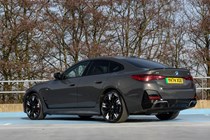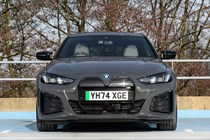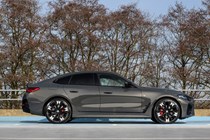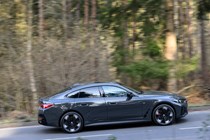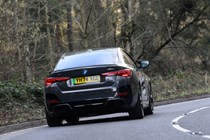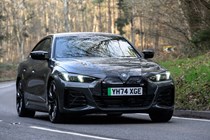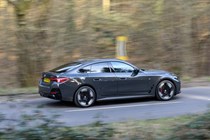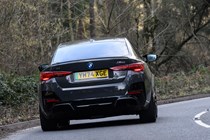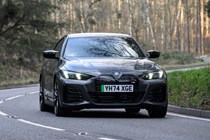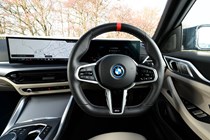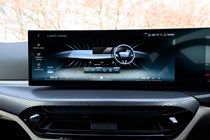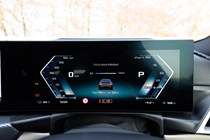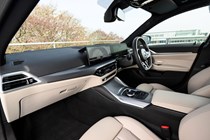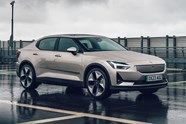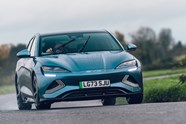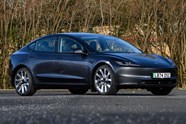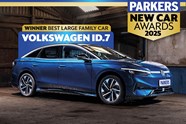
BMW i4 review: Why we'd have one over a Tesla Model 3

At a glance
| Price new | £51,370 - £71,000 |
|---|---|
| Used prices | £22,112 - £44,016 |
| Road tax cost | £195 - £620 |
| Insurance group | 34 - 45 |
Get an insurance quote with

|
|
| Fuel economy | 2.8 - 4.3 miles/kWh |
| Range | 257.9 - 380.9 miles |
| Miles per pound | 4.4 - 12.6 |
| Number of doors | 5 |
| View full specs for a specific version | |
Available fuel types
Fully electric
Pros & cons
- Long electric range
- High quality interior
- Stunning performance
- Expensive to buy with cash
- Limited rear headroom
- Not as nimble as a 3 Series
BMW i4 Gran Coupe rivals
Overview
Should you buy a BMW i4?
Yes, the BMW i4 has long been one of our favourite electric cars, and even though it’s not the newest EV in its class, we would still rate it as the best. It’s our reigning Company Car of the Year for good reason.
Its ability to blend a high-quality interior with a great driving experience put it ahead of the popular Tesla Model 3, and it’s also got an excellent range and efficiency on its side.
What is it?
The BMW i4 is a zero-emission version of the BMW 4 Series Gran Coupe that proves electric cars can appeal to driving enthusiasts – and that going fully electric doesn’t mean you have to make huge compromises.
What’s more, because the i4 doesn’t emit any carbon dioxide, it’s a screamingly attractive company car. You’ll only pay 3% Benefit in Kind from the start of the 2025/2026 tax year, which means you can have a top-spec M50 model on your drive for just over £2,000 a year. That’s why we gave it our 2025 Company Car of the Year award.
It starts to look even better when you compare the i4 to its rivals. Competitors include the likes of the BYD Seal, Polestar 2, Tesla Model 3 and Volkswagen ID.7 – but none drive quite as sweetly and none command the same level of prestige.
BMW revised the i4 in spring 2024, dragging some of its newest technology into what’s now the oldest EV in the brand’s line-up. The tweaks were fairly minor, consisting of some new headlights, fresh taillights and a reworked interior that now features the brand’s latest Curved Display infotainment system.
More recently, in summer 2025, BMW’s M50 range-topper was renamed to the M60, getting an extra 57bhp in the process, meaning it now develops more than 600hp. That’s more than even the most powerful BMW M3. More efficient electronic power units on the other two i4 models have also helped extract an extra 14 miles of electric driving range, too. We will add that we are yet to test these new versions, but we’ll report back when we do.
The i4’s styling is identical to the petrol-powered 4 Series and it shares the same simple cabin, which sets it apart from the hyper-futuristic Hyundai Ioniq 6 and Porsche Taycan.
There are three powertrains to choose from. At the lowest end of the spectrum, there’s the 286hp eDrive35 and 340hp eDrive40 both of which are rear-wheel drive. Above that, there’s the storming (and four-wheel drive) 544hp M50 (now the 601hp M60).
The eDrive35 is powered a 67.1kWh battery pack that provides a maximum WLTP driving range of 319 miles. The eDrive40 model has a larger 81.9kWh battery pack that bumps range up to 380 miles. The M50 uses the same battery but, because it has an extra motor, it’s less efficient and can only cover up to a claimed 338 miles between charges.
Over the next few pages, we’ll assess each aspect of the BMW i4 considering its practicality, interior quality, technology, driving experience and running costs before offering our final verdict on the car. If you’d like to learn more about how we assessed the i4, check out our how we test cars explainer page.
If you’re more of a visual learner, we’ve also recorded a BMW i4 video review. Click on the thumbnail below to watch it.
Watch our BMW i4 video review





